

After traveling in Indonesia by land and sea, from Timor to eastern Java, on 5th August we took a short flight from Jakarta to Singapore. We had been in Indonesia for a full two months and so needed to hop over to Singapore in order to renew our visas.

 Singapore was just as I had expected it to be -
modern, efficient and super clean. It was interesting walking around the different
quarters of the city. The Indian quarter was surprisingly unsanitized, but had some great
Indian food at give-away prices. The famous 'Hawker Centers' food halls were exceptional
and it was fun to try all of the different Asian dishes. The old colonial downtown was
fairly interesting, but for me the highlight was a visit to the grand old Raffles Hotel.
Michelle and I put on our 'best' clothes and went for High Tea in the Tiffin Room, before
retiring to the Long Bar for a 'Singapore Sling' or two. It was an expensive little treat
that just had to be done!
Singapore was just as I had expected it to be -
modern, efficient and super clean. It was interesting walking around the different
quarters of the city. The Indian quarter was surprisingly unsanitized, but had some great
Indian food at give-away prices. The famous 'Hawker Centers' food halls were exceptional
and it was fun to try all of the different Asian dishes. The old colonial downtown was
fairly interesting, but for me the highlight was a visit to the grand old Raffles Hotel.
Michelle and I put on our 'best' clothes and went for High Tea in the Tiffin Room, before
retiring to the Long Bar for a 'Singapore Sling' or two. It was an expensive little treat
that just had to be done!
After just 5 days in Singapore we took a ferry to the nearby island of Batam in Indonesia. From Batam we caught a high speed ferry through the Riau Archipelago, a bus up to Pekanbaru and then an overnight bus to Bukittinggi in western Sumatra. Due to it's 1000m altitude Bukittinggi had a cooler climate and made a comfortable base from which to explore the region. We spent a week or so in the town and did some day trips out to see the Buffalo fights at Kota Baru and the huge Rafflesia flowers - the world's largest blooms with a diameter of almost a meter! From Bukittinggi Michelle and I traveled up to Lake Maninjau, a huge flooded volcanic crater with 600m high walls. We found a great little losman (guest house) and spent several days swimming in the lake and generally relaxing in the idyllic surroundings.
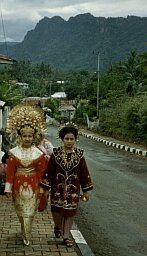
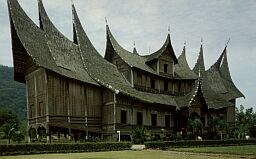 After Lake Maninjau Michelle and I decided to go our
separate ways. Michelle wanted to go off on a ten day trip to Siberut Island and I
preferred to explore the mainland. I had seen a poster in one of the losmans in
Bukittinggi asking for a teacher in the nearby town of Batusangkar, so I set off to check
it out. Batusangkar was about 50km from Bukittinggi, located on an upland plateau, and
surrounded by terraced rice paddies and mountains. The town was regarded as the core of
the Minangkabau homeland and the cultural center of the Minangkabau people. The town was a
fair size but still small enough not to be impersonal, and the people seemed genuine and
warm. There were no losman in the town so the only tourists were the occasional ones on
day trips.
After Lake Maninjau Michelle and I decided to go our
separate ways. Michelle wanted to go off on a ten day trip to Siberut Island and I
preferred to explore the mainland. I had seen a poster in one of the losmans in
Bukittinggi asking for a teacher in the nearby town of Batusangkar, so I set off to check
it out. Batusangkar was about 50km from Bukittinggi, located on an upland plateau, and
surrounded by terraced rice paddies and mountains. The town was regarded as the core of
the Minangkabau homeland and the cultural center of the Minangkabau people. The town was a
fair size but still small enough not to be impersonal, and the people seemed genuine and
warm. There were no losman in the town so the only tourists were the occasional ones on
day trips.
I quickly found the school which was called FIES (Family International English School) and had a good chat with the school director - Mr. Edy Edyson. Edy convinced me that I would have a great time teaching the students and that in return I would be able to learn the Indonesian language. Edy explained how I could eat with his family and stay with one of the students. It all sounded a great opportunity so I agreed to try it out for at least a few weeks. Before I had a chance to change my mind I was on the back of a motorbike on the way to meet the student who I would be staying with.
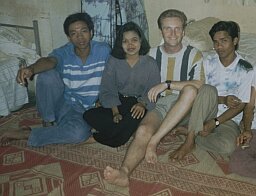 The house that I stayed at was conveniently located
about 500m meters from FIES and the center of town. There were two families living in the
house and a back room that I shared with Indrah, a FIES student. Our room was pretty
basic, but clean and comfortable enough. The bathroom consisted of an outside natural pool
with a fence around it. The idea was to simply scoop the water out of the pool and pour it
over one self - taking care not to scoop up any of the fish! I had a routine of taking a
'shower' at sunset every evening just as the fruit bats flew over - a world apart from
having a shower back at home in London!
The house that I stayed at was conveniently located
about 500m meters from FIES and the center of town. There were two families living in the
house and a back room that I shared with Indrah, a FIES student. Our room was pretty
basic, but clean and comfortable enough. The bathroom consisted of an outside natural pool
with a fence around it. The idea was to simply scoop the water out of the pool and pour it
over one self - taking care not to scoop up any of the fish! I had a routine of taking a
'shower' at sunset every evening just as the fruit bats flew over - a world apart from
having a shower back at home in London!
 FIES was a simple and friendly little school with two
classrooms, a small office with a secretary, and about 300 students. The students ranged
from 13 to 25 years and about 60% of them were female. I would often accompany the two
permanent teachers for conversation practice and would sometimes take my own grammar
classes. The classes were normally around 30 students with many of the female students
wearing veils. Most days I would do 2-3 hours teaching and would spend a considerable time
in the office with Dani, the secretary, practicing my Indonesian. I was quite surprised
how much I enjoyed the teaching and ended up staying at the school for around six weeks in
all. Edy Edyson also taught at a state school so I was a regular guest at his lessons
helping with conversation practice. One week I was even invited to speak at a local
teachers conference on the best methods to motivate the students and teach English!
FIES was a simple and friendly little school with two
classrooms, a small office with a secretary, and about 300 students. The students ranged
from 13 to 25 years and about 60% of them were female. I would often accompany the two
permanent teachers for conversation practice and would sometimes take my own grammar
classes. The classes were normally around 30 students with many of the female students
wearing veils. Most days I would do 2-3 hours teaching and would spend a considerable time
in the office with Dani, the secretary, practicing my Indonesian. I was quite surprised
how much I enjoyed the teaching and ended up staying at the school for around six weeks in
all. Edy Edyson also taught at a state school so I was a regular guest at his lessons
helping with conversation practice. One week I was even invited to speak at a local
teachers conference on the best methods to motivate the students and teach English!
My evening meals with Edy's family were always delicious. His wife, Nova, would prepare a range a Padang and Minangkabau dishes for us. The strict Muslim culture meant that Edy and I would sit down and eat first and then the rest of the family - I always felt a little uneasy about this. Some of the dishes included Rendang (Buffalo meat cooked in a rich, spicy, dry sauce), Dendeng (Buffalo meat cut into slices and fried until crispy with a hot chili sauce), Belut (Eel prepared in the same manner as Dendeng) and Curry Ayam (Chicken in a spicy coconut milk sauce). The food was normally served cold but was always fiery hot with chili.
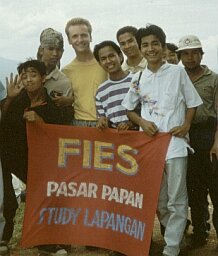
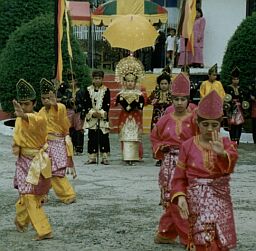 Over the six weeks I taught at the school I went on
several field trips with the students. The trips included a visit to Lake Singkarak;
climbing the Puncak Pato mountain; visiting Pagaruyung, the Minangkabau sultan's palace;
and going to the local horse races. On a trip up to the volcano of Gunung Bungsu we were
all in a minivan climbing a steep mountain track when the driver lost control and we went
over the edge. Miraculously there was a thick patch of young trees that prevented us from
falling to our deaths! There were quite a few minor injuries but we all managed to climb
back up to the road. I also attended the retirement ceremony of the local Bupati (Mayor),
where I was treated to a display of the traditional Pencak Silat dances (A form of western
Sumatran martial art adapted for dance).
Over the six weeks I taught at the school I went on
several field trips with the students. The trips included a visit to Lake Singkarak;
climbing the Puncak Pato mountain; visiting Pagaruyung, the Minangkabau sultan's palace;
and going to the local horse races. On a trip up to the volcano of Gunung Bungsu we were
all in a minivan climbing a steep mountain track when the driver lost control and we went
over the edge. Miraculously there was a thick patch of young trees that prevented us from
falling to our deaths! There were quite a few minor injuries but we all managed to climb
back up to the road. I also attended the retirement ceremony of the local Bupati (Mayor),
where I was treated to a display of the traditional Pencak Silat dances (A form of western
Sumatran martial art adapted for dance).
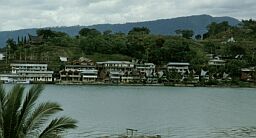 My stay in Batusangkar was certainly a rich cultural
experience, but after six weeks I got itchy feet and decided to travel up to Lake
Toba in northern Sumatra. Lake Toba was a beautiful place, situated on the equator at a
altitude of 900m, it had a perfect climate. The waters of the lake were clear and warm and
made for great swimming and relaxation. I found a great little losman on the Tuk Tuk
peninsular on the large Samosir Island in the middle of the lake. Lake Toba was an
established traveler hangout and so there were plenty of other backpackers, restaurants,
bars and social life in general. After my total immersion in the Indonesian culture of
Batusangkar I had expected to hang out with foreigners, but strangely I seemed to prefer
the company of the locals.
My stay in Batusangkar was certainly a rich cultural
experience, but after six weeks I got itchy feet and decided to travel up to Lake
Toba in northern Sumatra. Lake Toba was a beautiful place, situated on the equator at a
altitude of 900m, it had a perfect climate. The waters of the lake were clear and warm and
made for great swimming and relaxation. I found a great little losman on the Tuk Tuk
peninsular on the large Samosir Island in the middle of the lake. Lake Toba was an
established traveler hangout and so there were plenty of other backpackers, restaurants,
bars and social life in general. After my total immersion in the Indonesian culture of
Batusangkar I had expected to hang out with foreigners, but strangely I seemed to prefer
the company of the locals.
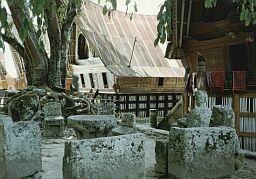 I quickly developed a daily routine of a morning
swim, a lazy breakfast, catching up with my diary, a long lunch, a siesta and then a few
beers at a local bar! I stayed for six days and managed to squeeze in a visit to the
carved stone coffin of king Sidabutar in the village of Tomok, and the historic village of
Ambarita with its fine high prowed Batak houses. Ambarita also had a group of 300 year old
stone chairs where villagers would settle their disputes, and another set of chairs that
were used as a court to try criminals. Convicted criminals were executed and then eaten -
the last time being early in the twentieth century!
I quickly developed a daily routine of a morning
swim, a lazy breakfast, catching up with my diary, a long lunch, a siesta and then a few
beers at a local bar! I stayed for six days and managed to squeeze in a visit to the
carved stone coffin of king Sidabutar in the village of Tomok, and the historic village of
Ambarita with its fine high prowed Batak houses. Ambarita also had a group of 300 year old
stone chairs where villagers would settle their disputes, and another set of chairs that
were used as a court to try criminals. Convicted criminals were executed and then eaten -
the last time being early in the twentieth century!
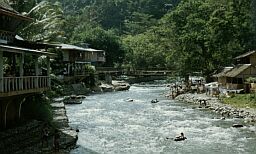 Next I headed further north to the town of Bukit
Lawang on the edge of the huge Gunung Leuser National Park. The town really only consisted
of a string of buildings on the banks of the fast flowing Borok river, deep in the
tropical rainforest. While in Bukit Lawang I went 'Tubing' down the river in a truck inner
tube. The 3 hour, 12km, ride down the white waters of the Borok river was quite a rush. It
certainly wasn't one of the safer things that I had done, but it was really fun. It seemed
that half of the thrill seekers returned to Bukit Lawang with injuries - I was lucky.
Next I headed further north to the town of Bukit
Lawang on the edge of the huge Gunung Leuser National Park. The town really only consisted
of a string of buildings on the banks of the fast flowing Borok river, deep in the
tropical rainforest. While in Bukit Lawang I went 'Tubing' down the river in a truck inner
tube. The 3 hour, 12km, ride down the white waters of the Borok river was quite a rush. It
certainly wasn't one of the safer things that I had done, but it was really fun. It seemed
that half of the thrill seekers returned to Bukit Lawang with injuries - I was lucky.
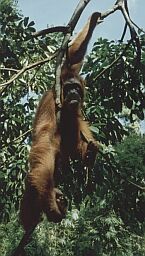 Bukit Lawang was famous for the Orangutan
Rehabilitation Center and this is what I had really come to see. It was a fantastic
experience being able to get so close to these amazing creatures and it was clear why they
were called Orangutan (Man of the Forest in Indonesian). One of the highlights was
watching the rangers give out the morning feed, where the mothers and babies would come
down from the trees and take the handouts. Some of the Orangutans had quite an attitude
and it was plain to see that working with these powerful creatures was certainly not
without risk! On one occasion one of the Orangutans came really close to me and held out
it's hand. Apprehensively I put out my hand and the ape touched it. It was amazing to
interact so closely with these intelligent creatures. I visited the rehabilitation center
twice and each time I found it equally fascinating. I spent 4 days in Bukit Lawang and
then headed back down to Medan, where I had a ticket arranged for a boat to Malaysia.
Another two months had flown by in Indonesia so my visa was up and it was time to leave
again.
Bukit Lawang was famous for the Orangutan
Rehabilitation Center and this is what I had really come to see. It was a fantastic
experience being able to get so close to these amazing creatures and it was clear why they
were called Orangutan (Man of the Forest in Indonesian). One of the highlights was
watching the rangers give out the morning feed, where the mothers and babies would come
down from the trees and take the handouts. Some of the Orangutans had quite an attitude
and it was plain to see that working with these powerful creatures was certainly not
without risk! On one occasion one of the Orangutans came really close to me and held out
it's hand. Apprehensively I put out my hand and the ape touched it. It was amazing to
interact so closely with these intelligent creatures. I visited the rehabilitation center
twice and each time I found it equally fascinating. I spent 4 days in Bukit Lawang and
then headed back down to Medan, where I had a ticket arranged for a boat to Malaysia.
Another two months had flown by in Indonesia so my visa was up and it was time to leave
again.
 On 8th October I caught a high speed ferry from
Belawan, the port for Medan, across to Georgetown on the island of Penang in Malaysia.
Georgetown was an interesting blend of Malay, Indian and Chinese cultures with a colonial
heritage. The Indian quarter was particularly vibrant as they were preparing for the Hindu
festival of Deepavali. I spent several days exploring the Chinese temples, the Indian
quarter and the old colonial buildings. There were also some great old coffee shops to
pass the afternoon chatting with other travelers. The food in Georgetown was as
diverse as its people and my evening meal was usually the highlight of the day.
On 8th October I caught a high speed ferry from
Belawan, the port for Medan, across to Georgetown on the island of Penang in Malaysia.
Georgetown was an interesting blend of Malay, Indian and Chinese cultures with a colonial
heritage. The Indian quarter was particularly vibrant as they were preparing for the Hindu
festival of Deepavali. I spent several days exploring the Chinese temples, the Indian
quarter and the old colonial buildings. There were also some great old coffee shops to
pass the afternoon chatting with other travelers. The food in Georgetown was as
diverse as its people and my evening meal was usually the highlight of the day.
From Georgetown I caught and express bus to Tanah Rata and the tea plantations of the Cameron Highlands. The 5 hour journey first took us across the 13km bridge from Penang to mainland Malaysia and then up into the cooler highlands. At 1,500m the Cameron Highlands were pleasantly cool and apparently ideal for growing tea. The countryside often looked rather English, especially as there were the occasional Mock Tudor houses dotted around. I visited one of the larger tea plantations called the Boh Tea Estate. As we walked through the estate we saw many of the Tamil tea pickers - just like on the box of PG Tips! We did an interesting tour of the tea processing factory and then sampled teas on the verandah of the main house - very civilized. I spent 6 days in the highlands visiting tea estates and doing several treks with the other travelers - a very enjoyable week.
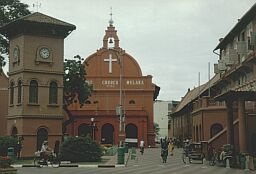 Next I traveled down to the capital of Malaysia,
Kuala Lumpur. KL was a pleasant enough modern Asian city and I ended up spending a week
checking it out. They were still building the twin towers of the Petronas Building - the
world's tallest building. While in KL I did some research into taking a TEFL English
language teaching course at the British Council. I passed the course acceptance exam and
interview, but was unsure whether I really wanted to do it. Finally I decided to think
about it and head down to explore Melaka. Melaka had been an important port on the old
trade routes and the home of three colonial powers i.e. Portuguese, Dutch and British. The
center of town had a sleepy backwater appeal to it and was dominated by the old Dutch
colonial buildings. One day I climbed up to a lookout on Bukit St. Paul and starred out of
the Straits of Melaka. I imagined the harbour full of merchant ships from all over the
world loaded with their precious cargoes.
Next I traveled down to the capital of Malaysia,
Kuala Lumpur. KL was a pleasant enough modern Asian city and I ended up spending a week
checking it out. They were still building the twin towers of the Petronas Building - the
world's tallest building. While in KL I did some research into taking a TEFL English
language teaching course at the British Council. I passed the course acceptance exam and
interview, but was unsure whether I really wanted to do it. Finally I decided to think
about it and head down to explore Melaka. Melaka had been an important port on the old
trade routes and the home of three colonial powers i.e. Portuguese, Dutch and British. The
center of town had a sleepy backwater appeal to it and was dominated by the old Dutch
colonial buildings. One day I climbed up to a lookout on Bukit St. Paul and starred out of
the Straits of Melaka. I imagined the harbour full of merchant ships from all over the
world loaded with their precious cargoes.
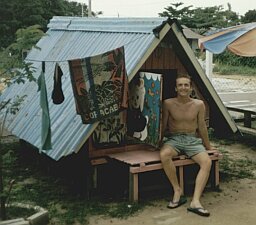 My final stop in Malaysia was a visit to the island
of Pulau Pangkor, where I had decided to hit the beaches for a week or so. Accommodation
on the island was relatively expensive so I ended up staying in a tiny decorated hut on a
campsite - more like a dolls house! The best beach, Coral Bay, was only 400m away and had
white sand, clear warm water and overhanging palm trees. After a few days I made some
local friends and we did several day trips on their motor boat out to some of the nearby
smaller islands. While on Pulau Pangkor I met a couple of fun German girls and we arranged
to meet up for Christmas back in Lake Toba, Indonesia. So it was back to Indonesia again
for my third visit.
My final stop in Malaysia was a visit to the island
of Pulau Pangkor, where I had decided to hit the beaches for a week or so. Accommodation
on the island was relatively expensive so I ended up staying in a tiny decorated hut on a
campsite - more like a dolls house! The best beach, Coral Bay, was only 400m away and had
white sand, clear warm water and overhanging palm trees. After a few days I made some
local friends and we did several day trips on their motor boat out to some of the nearby
smaller islands. While on Pulau Pangkor I met a couple of fun German girls and we arranged
to meet up for Christmas back in Lake Toba, Indonesia. So it was back to Indonesia again
for my third visit.
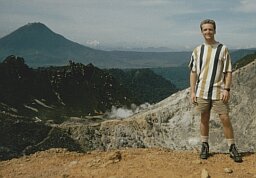 On 7th December I caught the high speed ferry from
Lumut, the port for Pulau Pangkor, back to Belawan in Indonesia. I couldn't believe I was
back for a third time - Indonesia was beginning to feel rather like home! This time I
headed up to the town of Brastagi as I wanted to climb the Gunung Sibayak volcano. I met
up with a group of other travelers and we got a nice room in a large old house with a real
fireplace - great since we were at an altitude of 1,300m and it was chilly at night! The
three hour climb up to the 2,095m crater rim of the volcano was beautiful. At the crater
there were several roaring steam vents and brightly colored patches of sulphur deposits.
The weather was perfect and we were rewarded with spectacular views out over the
surrounding countryside. On our decent we stopped for a well deserved soak in the natural
hot springs near to the village of Doulu - a great feeling after a tough hike! While in
Brastagi I also spent several days exploring the nearby Karo Batak villages with their
impressive traditional houses and distinct culture.
On 7th December I caught the high speed ferry from
Lumut, the port for Pulau Pangkor, back to Belawan in Indonesia. I couldn't believe I was
back for a third time - Indonesia was beginning to feel rather like home! This time I
headed up to the town of Brastagi as I wanted to climb the Gunung Sibayak volcano. I met
up with a group of other travelers and we got a nice room in a large old house with a real
fireplace - great since we were at an altitude of 1,300m and it was chilly at night! The
three hour climb up to the 2,095m crater rim of the volcano was beautiful. At the crater
there were several roaring steam vents and brightly colored patches of sulphur deposits.
The weather was perfect and we were rewarded with spectacular views out over the
surrounding countryside. On our decent we stopped for a well deserved soak in the natural
hot springs near to the village of Doulu - a great feeling after a tough hike! While in
Brastagi I also spent several days exploring the nearby Karo Batak villages with their
impressive traditional houses and distinct culture.
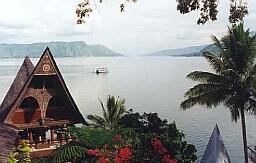 From Brastagi I headed down to the sleepy town of
Haranggaol on the north-east shore of Lake Toba. From Haranggoal it was a beautiful 3 hour
boat journey down to Tuk Tuk on Samosir Island. On the journey we stopped at some of the
more remote villages on the shore of Lake Toba. I arrived back at my losman in Tuk Tuk on
18th December. I had met up with two Canadian girls, Meg and Kirsten, and we decided we
would hang out together for Christmas and the New Year. We had a very enjoyable simple
Christmas together - it felt good to be away from the excesses of a Christmas back in the
West. So as not to be too lazy, between Christmas and the New Year I did an invigorating 2
day hike across Samosir Island and then caught a bus back to Tuk Tuk.
From Brastagi I headed down to the sleepy town of
Haranggaol on the north-east shore of Lake Toba. From Haranggoal it was a beautiful 3 hour
boat journey down to Tuk Tuk on Samosir Island. On the journey we stopped at some of the
more remote villages on the shore of Lake Toba. I arrived back at my losman in Tuk Tuk on
18th December. I had met up with two Canadian girls, Meg and Kirsten, and we decided we
would hang out together for Christmas and the New Year. We had a very enjoyable simple
Christmas together - it felt good to be away from the excesses of a Christmas back in the
West. So as not to be too lazy, between Christmas and the New Year I did an invigorating 2
day hike across Samosir Island and then caught a bus back to Tuk Tuk.
For New Year we all went to an all night party at Leo's Bar in Tuk Tuk. The festivities began with a delicious BBQ of chicken and Ikan Mas (Gold Fish), followed by the usual excessive drinking. Leo's Bar put on a free breakfast at sunrise and then we all crawled back to our losman. It was strange to think a whole year had passed since I was in Sydney with my brother - I hadn't really traveled very far in a year!